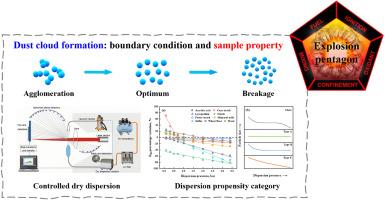Developing laser diffraction as an approach to categorize the dispersion propensity of combustible dust
IF 4.2
3区 工程技术
Q2 ENGINEERING, CHEMICAL
Journal of Loss Prevention in The Process Industries
Pub Date : 2025-07-03
DOI:10.1016/j.jlp.2025.105734
引用次数: 0
Abstract
The dispersion of combustible dust into airborne clouds constitutes one of the five prerequisites for dust explosions. The process is predominantly governed by initial conditions, with specific material characteristics exerting measurable influences. For example, dust with good dispersibility has a higher tendency to form clouds and stay airborne. Dust prone to breakage is more likely to be distributed in smaller sizes. This study develops an experimental approach employing sequential particle size analysis through a dry dispersion laser diffractometer. Nine industrially relevant dust samples (i.e., ascorbic acid, corn starch, lycopodium, niacin, potato starch, skimmed milk, sulfur, wheat flour, and wood) were characterized under controlled dispersion pressures from 0.1 to 3.4 bar. The results show the degree of dispersion or comminution can be distinguished by monitoring the change in size distribution. In general, the fine fraction in the distribution increases at first upon increasing the dispersing energy due to improved dispersion. At higher energies, the amount of fines rises again if the particles start to break up. Sample-specific response patterns emerge in the pressure titration curves: smooth plateaus indicate optimal dispersion for easily dispersible and robust dusts, versus continuous size reduction trajectories revealing poor dispersion and fragile dusts. This qualitative categorizing method enables simultaneous evaluation of both dispersion efficiency and particle integrity, supplementing the pathway for assessing dust explosion hazards across laboratory and industrial scenarios.

发展激光衍射作为可燃粉尘分散倾向分类的方法
可燃粉尘向空气云中扩散是粉尘爆炸的五个先决条件之一。该过程主要受初始条件的支配,特定的材料特性产生可测量的影响。例如,分散性好的灰尘更容易形成云并停留在空气中。容易破碎的粉尘更容易以较小的尺寸分布。本研究发展了一种通过干色散激光衍射仪进行连续粒度分析的实验方法。9种工业相关粉尘样品(抗坏血酸、玉米淀粉、番茄碱、烟酸、马铃薯淀粉、脱脂牛奶、硫、小麦粉和木材)在0.1 ~ 3.4 bar的分散压力下进行了表征。结果表明,可以通过监测粒度分布的变化来区分分散或粉碎的程度。一般情况下,随着分散能量的增加,分布中的细组分首先增加,这是由于分散性的改善。在更高的能量下,如果粒子开始分裂,微粒的数量又会上升。样品特异性响应模式出现在压力滴定曲线中:平滑的平台表明易分散和坚固的粉尘的最佳分散,而连续的尺寸减小轨迹表明分散性差和脆弱的粉尘。这种定性分类方法可以同时评估分散效率和颗粒完整性,补充了评估实验室和工业场景中粉尘爆炸危害的途径。
本文章由计算机程序翻译,如有差异,请以英文原文为准。
求助全文
约1分钟内获得全文
求助全文
来源期刊
CiteScore
7.20
自引率
14.30%
发文量
226
审稿时长
52 days
期刊介绍:
The broad scope of the journal is process safety. Process safety is defined as the prevention and mitigation of process-related injuries and damage arising from process incidents involving fire, explosion and toxic release. Such undesired events occur in the process industries during the use, storage, manufacture, handling, and transportation of highly hazardous chemicals.

 求助内容:
求助内容: 应助结果提醒方式:
应助结果提醒方式:


